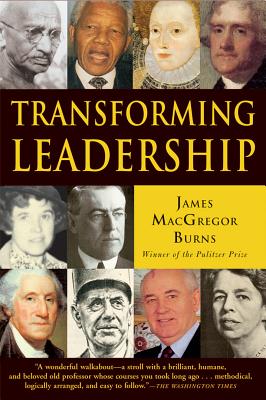Transforming Leadership

Transforming Leadership
In 1978, Pulitzer Prize and National Book Award-winning historian James MacGregor Burns published Leadership, a seminal book dealing with how leaders interact with society and through their efforts have the power to shape the course of history. The book became the basis for an emerging field of leadership studies that has been applied throughout the social sciences as well as in business and government. Now Burns has returned to the subject, offering a new vision of leadership-Transforming Leadership-that focuses on the ways that leaders emerge from being ordinary "transactional" brokers and deal-makers to become real agents of major social change who empower their followers. Through the course of the book, Burns illuminates the evolution of leadership structures, from the chieftains of tribal African societies, through Europe's absolute monarchies, to the blossoming of the Enlightenment's views of liberty that came to fruition in the American Revolution. Along the way he looks at key moments in leadership, and the great leaders who made them, including Cleopatra, Elizabeth I, James Madison, Napoleon, Mao, Gandhi, and Mikhail Gorbachev. Part One: Change
Chapter 1: The Mysteries of Leadership An introduction to Burns' concept of leadership-how leaders differ from tyrants, and transactional leaders from transforming leaders-and how this differs from other "Great Man" views of history. Chapter 2: Searching for the X-Factor
Looking at his own studies of FDR and other leaders, Burns looks at how change emanates from society, and how this shapes community and society. Leadership is the "X-Factor" that brings change from concept to social reality. Part Two: Leaders
Chapter 3: Kings and Queens, Knights and Pawns Using the game of chess as a metaphor for leadership action in monarchical society, Burns looks at the leadership systems of African tribes, and how monarchy evolved to the absolute model in post-Renaissance Europe, with a portrait of Elizabeth I's successful leadership during a turbulent period in English history. Chapter 4: Leaders as Planners A look at transforming leadership outside the political arena, including the building of the Suez and Pana
PRP: 80.00 Lei
Acesta este Pretul Recomandat de Producator. Pretul de vanzare al produsului este afisat mai jos.
72.00Lei
72.00Lei
80.00 LeiIndisponibil
Descrierea produsului
In 1978, Pulitzer Prize and National Book Award-winning historian James MacGregor Burns published Leadership, a seminal book dealing with how leaders interact with society and through their efforts have the power to shape the course of history. The book became the basis for an emerging field of leadership studies that has been applied throughout the social sciences as well as in business and government. Now Burns has returned to the subject, offering a new vision of leadership-Transforming Leadership-that focuses on the ways that leaders emerge from being ordinary "transactional" brokers and deal-makers to become real agents of major social change who empower their followers. Through the course of the book, Burns illuminates the evolution of leadership structures, from the chieftains of tribal African societies, through Europe's absolute monarchies, to the blossoming of the Enlightenment's views of liberty that came to fruition in the American Revolution. Along the way he looks at key moments in leadership, and the great leaders who made them, including Cleopatra, Elizabeth I, James Madison, Napoleon, Mao, Gandhi, and Mikhail Gorbachev. Part One: Change
Chapter 1: The Mysteries of Leadership An introduction to Burns' concept of leadership-how leaders differ from tyrants, and transactional leaders from transforming leaders-and how this differs from other "Great Man" views of history. Chapter 2: Searching for the X-Factor
Looking at his own studies of FDR and other leaders, Burns looks at how change emanates from society, and how this shapes community and society. Leadership is the "X-Factor" that brings change from concept to social reality. Part Two: Leaders
Chapter 3: Kings and Queens, Knights and Pawns Using the game of chess as a metaphor for leadership action in monarchical society, Burns looks at the leadership systems of African tribes, and how monarchy evolved to the absolute model in post-Renaissance Europe, with a portrait of Elizabeth I's successful leadership during a turbulent period in English history. Chapter 4: Leaders as Planners A look at transforming leadership outside the political arena, including the building of the Suez and Pana
Detaliile produsului









